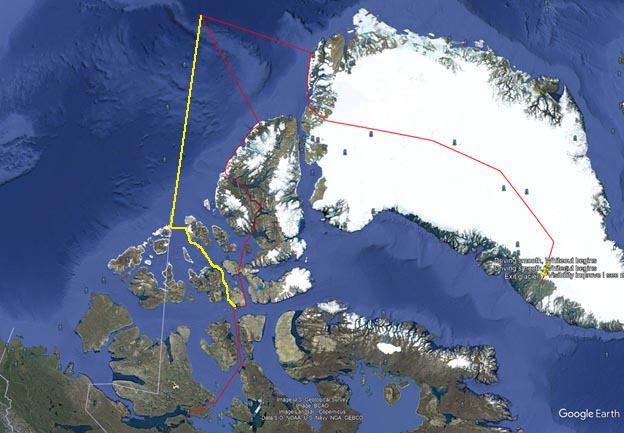Arctic leg of a transglobal car expedition
06.04.2024 11 years have passed. Day after day again at the Pole.
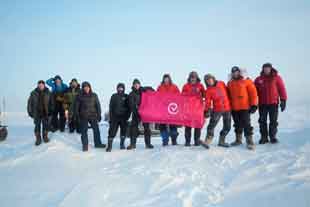
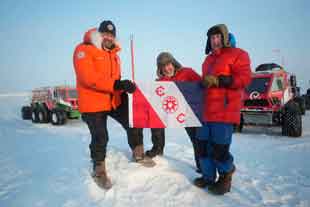
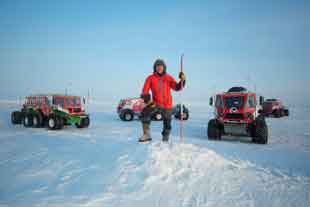
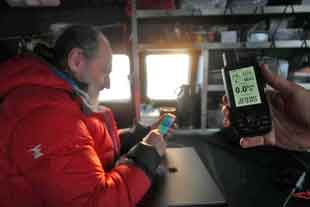
20.02.2024 Today Vasily Yelagin - permanent leader of all expeditions on "Yemelya" ATVs, the designer of "Yemelya" ATVs, Master of sports of international grade in mountaineering, the winner of medals of the USSR championships in mountaineering, participant of Paris-Dakar rally, and simply a wonderful man - is 71. Happy birthday to you, Vasily! We wish you good health, great opportunities, inexhaustible strength and energy. Let success and good luck always follow you in life. Let this expedition not be left without luck as well. Less hummocks, more good weather, favorable wind and seven feet under the keel :)))
12.02.2024 Most regrettably, the originally planned route with egress to the vastness of the Arctic Ocean from the islet called Ward Hunt (near Ellesmere Island) which is closest to the pole had to be changed. The new route is almost one and a half times longer. Canada has not endorsed passing over Tallurutiup Imanga National Marine Conservation Area organized in these places. This Conservation Area was established in August 2019 for the purpose of contributing to the conservation, protection and understanding of natural diversity, productivity and dynamism of the sea ice ecosystem in the Arctic. Tallurutiup Imanga is the first National Marine Conservation Area which was assigned temporary protection by order of the Ministry according to the Law on Oceans. According to the decree, any new or additional human activity is prohibited in this area for up to five years, with the following exceptions:
- Implementation of Inuit rights in regard of exploitation of wildlife, as stipulated by the Nunavut Agreement.
- Marine scientific research consistent with the nature-preserving objectives of MPA. (Marine Protected Area).
- Safety, security and emergency activities.
- Certain activity performed by a foreign citizen, legal entity, ship or State.
MPA provides temporary protection for this territory, while the Qikiqtani Inuit Association, the Government of Nunavut and the Government of Canada are working with Inuit and northern partners, studying the possibility of long-term protection of this territory.
Planned route for the Arctic leg of the transglobal car expedition
10.02.2024Vasily Yelagin, the expedition leader and the designer of Yemelya ATVs, finally joined the expedition.
04.02.2024 The Russian part of the team reached Cambridge Bay. Read about all the events in the diary of Arctic leg of a transglobal car expedition.
Test Drive-2023
21.04.2023 Test drive 2023 is over. Odometer reading 1650 km. We are in Cambridge Bay.
07.04.2023 First full day on the trek. 175 km covered.
22.03.2023 Hurray! We got to Cambridge Bay finally.
15.03.2023 Today a team led by Vasily Yelagin flew from Istanbul to Toronto for a test drive. Read about all the events in the expedition diary.
Test Drive-2022
31.03.2022 By 11:00 the body of the author of these lines, exhausted by important tests, together with the entire caravan was delivered to Cambridge Bay, where our run of this year was finished.
11.02.2022 Today a team led by Vasily Yelagin flew from Warsaw to Toronto for a test drive. Read about all the events in the expedition diary.
Antarctica. 200 years of discovery. Moscow.
Well, one more expedition came to an end. Antarctica, the ice continent, the South pole. How many fearfully loud epithets and definitions! Here are the "snow ridges as high as a man", "snow swamps" in which mighty tracked off-roaders and beautiful Toyotas of "Arctic Trucks" get drowned. Here are the dome altitudes of 3500 m which, according to the Antarctic devotees, are equivalent to 5500 m in the middle latitudes, and the whiteout, - all this was narrated to us with the words: "and do not even try to compare this with your Arctic, - everything here is much worse, more difficult and more dramatic", or, as they say in the army, "for your information, here it's not as there". We were lucky; having heard so many descriptions of almost insurmountable difficulties from people who, highly likely, has never spent the winter term at the stations, sometimes they were just office-holders who with candid pleasure, not to say - with delight, emblazed the horrors of the Ice Continent, while they never faced actual field conditions, - we realized that this was an obvious "overshoot", and even relaxed to some extent. Long ago it was noticed: the less a man has something serious in his biography, the more pathos and high-sounding words are in his speeches and the descriptions of the "hardships of travel". And only a few experienced polar explorers with whom we had a chance to talk in quite atmosphere told us: "guys, do not get nervous, the ascent on the dome will not be a problem, most of it is low-angle, and on short steep sections you will strain a little and get over. There are no crevasses on the dome, all of them are concentrated in the coastal zone, and for your vehicles of "cockroach" weight, considering your mountaineering experience, crevasses will not pose a serious danger. And speaking about winds and frost, - well, appropriate equipment and experience of Arctic expeditions will help you." We are extremely thankful to Lev Mikhailovich Savatyugin for such an assessment of Antarctic environment, everything he said was absolutely accurate and corresponding to the reality. Thank you very much, Lev Mikhailovich! And the reward for endless staying at the steering wheel on the route was: encounters with the people for whom Antarctica is neither a method nor a reason to tell about their courage and heroism, but just the working place, and their motivation is interest, not money, this is especially true in regard of our compatriots. There are few places on the "mainland" where you'll meet such a concentration of people with positive energy; what is interesting - according to my observations, this is true for all strata of this mini-socium. Mikhail, the machine operator of DES (diesel power station) at Progress, with enthusiasm showed us the water treatment system of the station, multi-circuit heating scheme which is much more efficient as compared to the old stations, and even the object of his special pride - hydroponic vegetable garden. Anton, the diesel operator from Vostok station, let his room at the station to a young lady - glaciologist who has arrived for the summer season, and himself moved to dwell into the old Kharkovchanka. He has not been at home for two and a half years already, he had to depart a year ago, but it turned out that there was no diesel operator at Vostok station, he was asked to stay - and he stayed, without losing the good mood. If that is necessary - let it be, minor issue. Those who have ever been to Vostok station will be less whining and complaining about the ups and downs of fate, one has only to refresh memory about these people. And we were really glad when the mechanics from Novolazarevskaya station, having invited the three of us to their small house, demonstrated their films about the "iron marches" on Kharkovchankas from Mirny to Vostok, asked us about the details of our journey, and said at parting: "lads, come to us, the right people are needed here." Then was the flight to Cape town, a most wonderful excursion around the town and the surroundings arranged by one more Mikhail who is living for a long time there, and then another 15 hours of net flight time - and we landed at Domodedovo. Achieving the objective is depriving of it, as someone of the clever or great has said. Once again, the pensioners have to scratch their heads, think of something interesting, since it is necessary to continue to LIVE somehow, right? V.Ye.
Antarctica 2018-2019.
January 6, 2019, expedition finished at Progress station.
December 29, 2018, expedition arrived at Vostok station.
December 23, 2018, expedition reached the South Pole.
December 17, 2018, at about 15 o'clock, the expedition reached the first planned target-pole of inaccessibility.
We track the movement of the expedition on the GPS tracker and can show the distance traveled in Iridium360° service. GPS tracker and the service of obtaining coordinates from it are provided by the sponsor of the road crossing, the company Satellite Telecom°
Antarctica 2018. What is common and what are the differences between our travels in the Arctic and in Antarctica?
In both cases, patience and prudence are necessary; it is always better to stop and go on foot, to observe an obstacle or a suspicious place, and only then to drive further on. The spent time is definitely much less than the time to repair or replace a twisted driving shaft or a broken hitch unit. Sometimes it is necessary to drive in the white haze though one would prefer to wait, but this atmospheric phenomenon may last very long, and the tight schedule compels to move. Sometimes this ends up with vehicle roll-over; it should be avoided by all means. The obstacles requiring careful observation are: in the Arctic - fields of fresh ice; if such ice becomes broken, it is impossible neither to sail nor to get out. Therefore, after gaining some experience, we walked for reconnaissance purposes, sometimes for a long time; firstly, it is useful for health, and secondly contributes to effective advance towards the destination point.
The obstacles in Antarctica are the crevasses, especially combined with white haze; the terrain is not visible, while in the areas of crevasses good visibility is especially important in order to detect by experienced eyes of a mountaineer the slightest signs of crevasses hidden by snow bridges.
That's what is in common.
And here are the differences:
In the Arctic the fields of fresh ice sometimes were so extensive that walking around them in search of safe passages could be endless, and so we started moving at full speed, solving on the move the task of projecting the proper trajectory, especially if a black strip of open water appeared ahead. The activity is creative and exciting, but highly risky, not for the reason of potential death of some of the participants, but because of the loss of the caravans caused by eventual ice push and subsequent romantic (or not very romantic) staying on an ice floe waiting for the arrival of the rescue team, what might last indefinitely long. The times nowadays are not the times of Chkalov-Gromov-Nobile-Vodopyanov, nobody cares for six or seven dudes that have willingly placed themselves in this ass. General Gavrilov, a very good and clever man, a military aircraft pilot, once told me: it is not enough for public recognition to climb a tree higher than anybody else; it is necessary that the state asked you to climb this tree higher than anybody else, and only then, Vasya, you will enjoy honor and respect. In this situation the only thing that saves us is that we need not universal honor and respect, quite enough would be the interest of a small circle of people who understand, and are interested in, what is happening in the high latitudes, and who get information not only through the blue embrasure of the most terrible weapon of all times and nations. Now about the obstacles in Antarctica: crevasses. If in the Arctic we used ladders for crossing narrow breaks, and it saved a lot of time, I decided not to take the ladders to Antarctica for one simple reason. In case of a pilot's error, falling into water on an amphibious ATV means only loss of time for its extraction, while in Antarctica falling into a crevasse most probably would be the end for the ATV and its crew. It's better to drive around, because we still have things to do at home.
Now about something not so sad: in order to improve the efficiency of movement of the vehicles and the carvans in whole, in Antarctica we decided to use TREKOL tires instead of the tires-shells, well-proven in the Arctic, produced by glorious and famous city of Bobruisk in fraternal Belarus. OSh-1 tires-shells are very elastic, they protect the suspension perfectly, but they are so soft that coasting is almost impossible; and in case of Antarctica with the announced length of autonomous route of 6000 km we have to use all opportunities for improvement of rolling. We shall actively work with pressure in the wheels; we took a few hand pumps as the primary remedy against the main hazard facing aircraft pilots, long-haul truckers and others - hypodynamia. And in order to preserve the vehicles, we will grit our teeth and patiently crawl over the boundless expanses of the Southern continent at half of the desired speed. Boredom and devastating rocking during the ride over famous Antarctic zastrugi at turtle speed will inevitably affect the mood of the participants of the travel, especially the mood of chechako. I read a lot of literature about Antarctica, especially interesting are the descriptions of sledge-track journeys, it helps to prepare psychologically for the upcoming adventures. I wish we were a bit lucky with the weather, the rest depends upon ourselves.
That's how the matters are.
P.S. My old friend's son works in South Africa for quite a long time. I talked to him on the phone, asked about the beauties of Cape town (they say, it's really beautiful); he confirmed: yes, a beautiful city, but it is strongly recommended for visitors not to walk around it on foot, because the guys with increased pigmentation of skin are too naughty there.
Antarctica 2018. A Ural company participates in the preparation of expedition to Antarctica.
In the framework of preparation to the project "Antarctica: 200th anniversary of the discovery" which will take place in December 2018 - January 2019, Vasily Elagin, a well-known traveler and our good friend whom we know by previous expeditions, addressed us with a request to assist in the preparation of vehicles and trailers for the upcoming journey.
The participants of the expedition on two ATVs Yemelya, with five trailers and two sledges, autonomously (carrying all the fuel, food, etc.) during two months will endeavor to travel about 6000 kilometers, mostly over the dome of Antarctica, at altitude above 3500 meters and at temperature down to - 50°C. A Uralian Alexei Makarov will participate in the expedition as a driver - mechanic. The route of the expedition will pass over three key points: the Pole of relative inaccessibility, the South pole and Vostok station located on the Southern geomagnetic pole. The expedition will start in late November.
ATVs Yemelya, already known and proven in polar expeditions, will be used as polar tractors pulling 3 tons of load, including fuel. The team led by Yelagin on these vehicles in 2009 reached the North pole for the first time, and in 2013 autonomously crossed the Arctic ocean to Canada, in that way visiting the North Pole twice, then traveled along the coast of Canada, Alaska, crossed the Bering Strait and returned to the port of Dudinka, thus completing the polar round-the-world trip. Neither before, nor after, no one else on wheeled vehicles managed to reach the North pole, the more so to do it twice.
Preparation for the expedition was carried out at the production facilities of "MAKAROV ALL-TERRAIN VEHICLES" OJSC. During 8 months a huge scope of work was completed by our specialists with the direct participation of Vasily Yelagin and Vladimir Obikhod. Many components and assemblies were almost completely rebuilt and replaced, the engines were replaced, internal and external appearance of the vehicles well-worn during the previous travels was refurbished properly. Four trailers and two sledges were made from scratch, one more trailer was substantially upgraded and brought to appropriate appearance. As during preparation to any serious journey, special attention was devoted to little things, because each of them may put the entire expedition on the brink of failure. Everything has to be taken into consideration: extremely low temperatures, fierce winds, glacier crevasses, dense snow with structure similar to ice, snow zastrugi (sharp ridges) sometimes 1.5 meters high, white haze when due to absence of any shadows a man does not see the terrain and the first vehicle moves practically blindly, snow "swamps" and much, much more.
Vasily Yelagin and Alexey Makarov know each other not so long. Once Alexey turned to Vasily for advice, and the latter provided comprehensive assistance in the preparation of our expedition to the North pole. Vasily on his ATV participated in the comparative tests of Arctic ATVs "Burlak" and "Yemelya" held in the snows of Subpolar Urals and Polar Urals, as well as on the drifting ice of the Kara sea. In course of intercommunication and in joint travels friendly relations developed between them, so the request for assistance in the preparation of the expedition "Antarctica: 200th anniversary of the discovery" was received by us with joy, all the more so because everything necessary is available: floor space, equipment, specialists, and the main component - experience in performing such work, because in essence we are engaged in the same activity. Finally by joint efforts the preparation was completed, and the caravans were shipped by sea in the direction of Antarctica; the team is also ready for departure, but by plane.
That's all. It is impossible either to predict something or to guarantee by 100%, the route is by no means an easy one. Any situation can arise on the move, but the basis of all is: preparedness. Let's hope that nothing was omitted, and of course we wish our guys: good luck and timely return to the home shores.
Antarctica 2018. On the website there is a film about preparation for the Antarctic expedition on all-terrain vehicles YEMELYA. The film was produced by Maria Makhach.
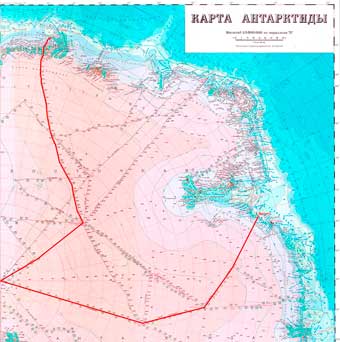
Antarctica 2018. The trip on Yemelya ATVs is timed to the 200th anniversary of the discovery of Antarctic Continent by the Russian expedition under the command of Bellingshausen and Lazarev. Valdis Pel'sh, who in the recent time is engaged in making documentary films, proposed us to endeavor an autonomous journey on the Southern continent visiting the three poles: the South pole, the southern Pole of inaccessibility and the Pole of cold (station Vostok). The length of the planned route is over 6000 km. A documentary film will be made during our journey. What are we planning to study and understand, bearing in mind that the South pole has been reached many times already on Toyota Hilux ATVs modified in Iceland by engineers of Arctictrucks company? Here is the answer:
- All journeys on Toyota off-road vehicles are possible only on condition of multiple refueling at points prepared in advance where the fuel is delivered by air in the required quantity. It is easy to imagine how much it costs, even without the imagination of Jules Verne or Herbert Wells.
- Participants of journeys on Toyota pickups were forced to bivouac in tents; this fact contributes to the impressions of the participants of these journeys (usually commercial journeys), but it is absolutely unsuitable for a long-term stay in the field required in course of various works such as surveying, glaciological, meteorological and other explorations.
- Sledge-crawler caravans with present-day snowcats as tractors are used widely and successfully, but often it is unreasonable to use them because of mismatch between their size and the required tasks. It is simply irrational to transport a group of two or three surveyors by a sledge-crawler caravan consuming 400-600 l of fuel per 100 km. The same applies to the travel of a film crew over the vastness of Antarctica.
Our «YEMELYA» off-roaders have passed extensive preparation and upgrade taking into consideration the specifics of Antarctic Continent. This includes high altitudes, strong winds with fine, all-pervading snow, very hard zastrugi (snow ridges), "snow swamps", etc. We are working, preparing, doing our best.
МЛАЭ-2015. On the website there is a film about MLAE-2015 «Way home». Leave your comments on page of the author of film Alexey Ushakov.
MLAE-2015. Message from the leader of MLAE-2015 Vasily Yelagin: "We are in Dudinka. Arctic round-the-world trip more than 16 thousand kilometers is completed."
MLAE-2015. The planned start date of the expedition - March 1, 2015. Total length of the route from Barrow to Dudinka is about 6000 km. Read about all the events in the expedition diary.
 |
 |
MLAE-2014. 19.04.2014. Message from MLAE-2014 leader Vasily Yelagin: "We are at Barrow; the expedition is interrupted due to falling behind schedule and quite complicated condition of ice in Bering Straight."
MLAE-2014. 05.03.2014 Today at 11:00 expedition SIAE-2014 consisting of: Elagin Vasily, Obihod Vladimir. Shkrabkin Alexei, Kozlov Nikolai, Kuptsov Vladimir, Ishakov Albert flew from Moscow to Ottawa with transfer in Toronto. Read about all the events in the expedition diary .
Main sponsor of the expedition  company "MARUSSIA"
company "MARUSSIA"
MLAE-2014. The planned path of return to Russia in the spring of 2014. 7000 km. along the coast of Canada, the U.S. and Russia. Here you can see the path of MLAE-2014 in Google Earth.
MLAE-2013 In the February issue of "World 4x4" magazine, "FROZEN MAJESTY" article about MLAE-2013 expedition has been published.
MLAE-2013 Announcements. Read the expedition's diary.
On the 9-th of May MLAE team has reached the village of Resolut. Happy Victory Day to everybody!
April 30, 2013. Ocean is behind us, we are on the fast ice now. Coordinates are N 83°07,928' W 075°59,059'.
EMBASSY OF THE RUSSIAN FEDERATION IN CANADA

285 Charlotte Street Ottawa, Ontario K1N 8L5
tel: (613) 235-4341, fax: (613) 236-6342, E-mail: info@rusembassy.ca
www.rusembassy.ca
PRESS RELEASE
08.04.2013
* * *
On the progress of the Marine Live-Ice Automobile Expedition
On April 6, 2013 the Marine Live-Ice Automobile Expedition which started in February 2013 has achieved its intermediate goal of reaching the North Pole from the closest land. It is the second time in the history of world auto industry that cars reached the North Pole. Both times this was done using “Yemelya” vehicles specially designed by the leader and organizer of the expedition Vasily Yelagin and built by the team members.
The expedition team of seven (Vasily Yelagin, Afanasiy Makovnev, Vladimir Obikhod, Alexey Shkrabkin, Andrey Vankov, Sergey Isaev and Nikolay Kozlov) is now preparing for the second difficult step which is to reach the Canadian settlement Resolute using only the fuel they had from the start of the route.
This trans-polar expedition which coincides with the year of Canada's assumption of chairmanship in the Arctic Council is a powerful and inspiring message for the future success of Russian-Canadian cooperation in Arctic exploration.
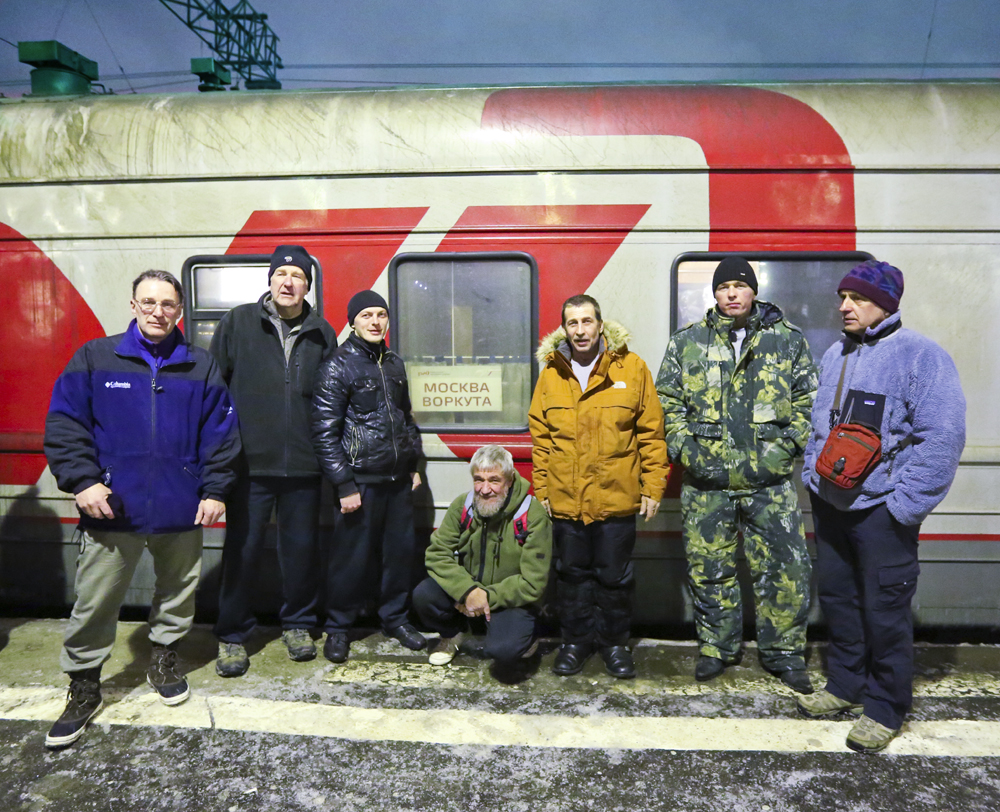
February 9, 2013 One of the greatest expeditions of the 21st century has quietly started on the perrone of the Yaroslavskiy train station in Moscow. YEMELYA-team: all seven members of the next Marine Live-ice Autmobile Expedition-2013: Makovnev Afanasy, Elagin Vasily, Vankov Andrey, Obikhod Vladimir, Shkrabkin Alexey, Kozlov Nikolai, Isaev Sergey.
MLAE-2011. On March 4, 2011 Marine Live-ice Automobile Expedition is scheduled to leave Urengoy, Russia and, under the flag of the Russian Geographic Society, to traverse the Arctic and the North Pole reaching Resolute Bay, Canada by June 15th 2011. The expedition is organized by Russian Center For Arctic Exploration and carried out under the patronage of the Special Representative of the President of Russian Federation In International Cooperation In The Arctic and The Antarctic the First vice-president of the Russian Geographic Society A.N. Chilingradov. The expeditionary crew will be traveling in two custom built amphibious vehicles "Yemelya-3" and "Yemelya-4" following the route: Urengoy - Dudinka - Dickson - Ostrov Russkij, Kara Sea - Ostrov Sredniy, Severnaya Zemlya archipelago- The North Pole - Ward Hunt, Canada - Resolute Bay, Canada.
Previous expedition MLAE-2009. In 2009 Marine Live-ice Automobile Expedition successfully traversed 2033 kilometers of the Arctic waters and ice between Ostrov Sredniy island of Severnaya Zemlya archipelago and The North Pole. The route took 38 days between 20th of March and the 26th of April 2009. The expedition was carried out under the patronage of Russian President's Special Representative for The International Cooperation in The Arctic and The Antarctic A.N. Chilingradov. The support and safety monitoring of the expedition and the crew was provided by the aviation department of Federal Security Bureau. Expedition was headed by the decorated Master of Sport V.I. Yelagin. Expeditionary crew consisted of seven people. Vehicles used to traverse the ice and water en-route were two custom designed and built vehicles "Yemelya-1" and "Yemelya-2" with three axels and 6x6 wheel drive equipped with diesel engines, low pressure tires and cargo trailers.

RUSSIAN BOOK OF RECORDS: The primary purpose of the MLAE-2009 - field testing of the vehicle capabilities on the floating ice terrain and reaching the North Pole by motor vehicle - has been successfully accomplished. The record of this unprecedented achievement now belongs to Russia. Previously, vehicles of this class had only been used for adventure sport purposes. However, at this point, Russian Center For Arctic Exploration have the capability to offer these unique amphibious vehicles to interested organizations and Northern communities for the purposes of search and rescue, traveling, hunting and scientific exploration. "Yemelya" - is a reliable new generation vehicle designed for safe transportation over various surfaces ranging from Tundra forests and winter lakes and rivers to floating ice of the Arctic ocean.
